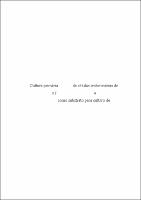| ???jsp.display-item.social.title??? |


|
Please use this identifier to cite or link to this item:
https://tede.ufrrj.br/jspui/handle/tede/759| ???metadata.dc.type???: | Dissertação |
| Title: | Cultura primária in vitro de células embrionárias de Rhipicephalus (Boophilus) microplus e Amblyomma cajennense como substrato para cultivo de Borrelia burgdorferi |
| Other Titles: | Primary culture in vitro of embryonic cells of the Rhipicephalus (Boophilus) microplus and Amblyomma cajennense as substratum for culture of Borrelia burgdorferi |
| ???metadata.dc.creator???: | Rezende, Jania de  |
| ???metadata.dc.contributor.advisor1???: | Fonseca, Adivaldo Henrique da |
| ???metadata.dc.description.resumo???: | Células embrionárias de carrapatos mantidas in vitro constituem uma importante ferramenta para cultivo e estudo da biologia de Borrelia burgdorferi. A espiroquetas B. burgdorferi é o agente etiológico da borreliose de Lyme nos EUA e Europa, onde é transmitida por carrapatos do gênero Ixodes. O objetivo deste trabalho foi cultivar in vitro Borrelia burgdorferi (Cepa Americana G39/40) em cultura primária de células embrionárias dos carrapatos Rhipicephalus (Boophilus) microplus e Amblyomma cajennense. A partir da cultura primária de células embrionárias de R. (Boophilus) microplus foram realizados subcultivos mantidos com meio Leibovitz s L-15 livre de antibiótico, que posteriomente foi trocado pelo meio Barbour-Stoener-Kelly (BSK). Após a adição do BSK na cultura, inoculou-se B. burgdorferi e também em Tubo de Leighton (TL) com BSK livres de células (controle), numa concentração final de 6x106 espiroquetas/mL. As células embrionárias de A. cajennense foram inicialmente cultivadas em meio L-15 com antibiótico, o qual foi substituído pelo BSK. Posteriormente, inoculou-se 1,1x107 espiroquetas/mL cultivadas em meio BSK, e também em TL controle livre de células. Todos os cultivos foram incubados em estufa bacteriológica a 34ºC. O desenvolvimento dos cultivos foram observados em microscópio de contraste de fase invertido, assim como as contagens de B. burgdorferi realizados em câmara de neubauer. As lamínulas dos TL foram coradas com Giemsa. Foi constatado pela observação em microscópio de contraste de fase invertido a sobrevivência, aderência e multiplicação de B. burgdorferi, nas células embrionárias de R. (Boophilus) microplus e A. cajennense. Não houve diferenças na contagem final de espiroquetas cultivadas em células de R. (Boophilus) microplus quando comparada ao controle livre de células, mas sobre células de A. cajennense o valor total de aproximadamente 1,9x107 espiroquetas/mL, e enquanto no tubo controle livre de células foi 1x106 espiroquetas/mL. O cultivo de células do carrapato R. (Boophilus) microplus e A. cajennense têm potencial para ser utilizado como substrato para cultivo de B. burgdorferi e para estudo de seu desenvolvimento. |
| Abstract: | Embryonic cells of tick in vitro constitute an important one tool for culture and study of the biology of B. burgdorferi. Spirochetes Borrelia burgdorferi is the aetiologic agent of borreliose of Lyme in U.S.A. and Europe, where it is transmitted by tick of the Ixodes genus. The aim of this work was in vitro to cultivate B. burgdorferi (American Cepa G39/40) in primary culture of embryonic cells of Rhipicephalus (B.) microplus and the A. cajennense. From the primary culture of embryonic cells of R. (B.) microplus were performed subculture maintained with medium Leibovitz's (L-15) free of antibiotic, that later it were changed by medium Barbour-Stoener-Kelly (BSK). After the addition of the BSK inoculated B. burgdorferi of and also in Tube of Leighton (TL) with free BSK of cells (control) in a final concentration of 6x106 spirochetes/mL. The embryonic cells of the A. cajennense initially were cultivated in medium L-15 with antibiotic, which was substituted by the BSK. Later, 1,1x107 spirochetes/mL in medium BSK cultivated was inoculated, and also in TL controlled free of cells. All the culture was incubated at 34ºC. The development of the culture was observed in microscope of inverted contrast of phase, as well as the countings of B. burgdorferi performed in chamber of neubauer. Cover glass of the TL had been stained with Giemsa. It was evidenced by the observation in microscope of inverted contrast of phase the survival, attach and multiplication of B. burgdorferi, in the embryonic cells of R. (B.) microplus and A. cajennense. It did not have differences in the finale counting of spirochetes cultivated in cells of R. (B.) microplus when compared with the free control of cells, but on with cells of the A. cajennense, the number amount approximately was 1,9x107 spirochetes/mL, and while in the tube it has controlled free of cells was 1x106 spirochetes /mL. The culture of cells of tick R. (B.) microplus and the A. cajennense have potential to be used as substratum for culture of B. burgdorferi, and study of its development. |
| Keywords: | cultivo celular Borrelia sp carrapato cellular culture tick |
| ???metadata.dc.subject.cnpq???: | Parasitologia |
| Language: | por |
| ???metadata.dc.publisher.country???: | Brasil |
| Publisher: | Universidade Federal Rural do Rio de Janeiro |
| ???metadata.dc.publisher.initials???: | UFRRJ |
| ???metadata.dc.publisher.department???: | Instituto de Veterinária |
| ???metadata.dc.publisher.program???: | Programa de Pós-Graduação em Ciências Veterinárias |
| Citation: | REZENDE, Jania de. Cultura primária in vitro de células embrionárias de Rhipicephalus (Boophilus) microplus e Amblyomma cajennense como substrato para cultivo de Borrelia burgdorferi. 2008. 22 f. Dissertação (Mestrado em Ciências Veterinárias, Parasitologia Animal) - Instituto de Veterinária, Universidade Federal Rural do Rio de Janeiro, Seropédica - RJ, 2008. |
| ???metadata.dc.rights???: | Acesso Aberto |
| URI: | https://tede.ufrrj.br/jspui/handle/tede/759 |
| Issue Date: | 22-Feb-2008 |
| Appears in Collections: | Mestrado em Ciências Veterinárias |
Files in This Item:
| File | Description | Size | Format | |
|---|---|---|---|---|
| 2008 - Jania de Rezende.pdf | 456 kB | Adobe PDF |  Download/Open Preview |
Items in DSpace are protected by copyright, with all rights reserved, unless otherwise indicated.




